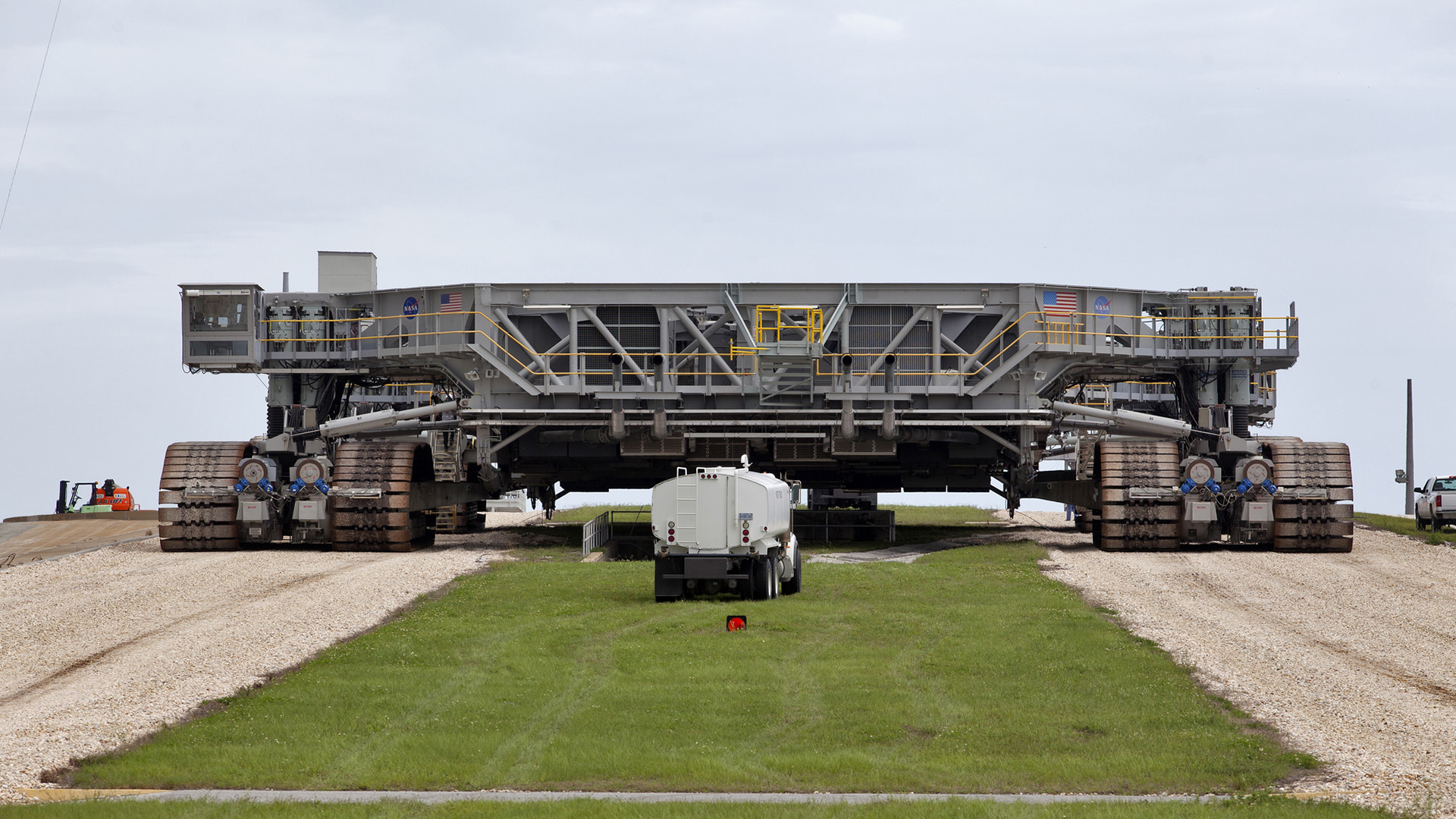Stacked 'Mega Moon rocket' is ready to roll, NASA says
Lunar mission Artemis I is about to roll closer to getting a launch date.

NASA's upcoming lunar mission Artemis I is about to roll a little closer to getting an official launch date. The stacked spacecraft and rocket have been cleared to trundle out to the launch pad at Kennedy Space Center in Cape Canaveral, Florida, on Thursday (March 17) for prelaunch tests, NASA representatives announced on Monday (March 14) at a press briefing.
The Orion spacecraft atop the Space Launch System (SLS) rocket — also known by NASA as the "Mega Moon rocket" — will make the 4-mile (6.4 kilometers) journey from Kennedy's Vehicle Assembly Building (VAB) to Launch Pad 39B, weather permitting. The rollout will start at 5 p.m. local time, and the rocket will take approximately 11 hours to reach its destination, carried by the Crawler-Transporter 2 at at a stately rolling speed of 0.8 mph (1.3 km/h), Charlie Blackwell-Thompson, launch director for NASA's Exploration Ground Systems Program at Kennedy, said at the briefing.
Once the spacecraft and rocket are positioned at the launch pad, engineers will take about two weeks to prepare for what is known as a "wet dress rehearsal," so named because these tests demonstrate that the rocket can be loaded with super-cold liquid propellants, according to NASA.
The "call to stations" for the wet dress rehearsal will likely be April 1, and tanking operations are expected to start on April 3, Blackwell-Thompson said. Engineers and technicians will also practice the launch countdown — to just inside T minus 10 seconds — to test the rocket's responses to a flight termination scenario, before wrapping up the rehearsal, draining the fuel tanks and preparing the rocket for its return to the VAB, which should take another eight to nine days, Blackwell-Thompson said.
Related: NASA prepares 'moonikin' for spaceflight aboard 1st Artemis mission
NASA's Orion spacecraft can hold up to four people, but it won't have any humans onboard when the Artemis I mission takes flight later this year. In future Artemis missions, Orion will carry astronauts into space, sustain them during their moon missions, and keep them safe during re-entry from deep space.
The spacecraft perches atop a beast of a rocket: SLS is the most powerful rocket NASA has ever built. It produces 15% more thrust during liftoff and ascent than the Saturn V rockets that flew during the space programs of the 1960s and 1970s, and the SLS will be able to carry more than 27 tons (24,000 kilograms) to the moon, Live Science previously reported.
Sign up for the Live Science daily newsletter now
Get the world’s most fascinating discoveries delivered straight to your inbox.
After the rollout — provided all tests are successfully completed — NASA will set an official launch date for Artemis I (currently listed as "no earlier than May 2022" on NASA's launch schedule). Artemis I is an uncrewed mission that will fly thousands of miles beyond the moon and then return to Earth after about three weeks. The next part of the mission, Artemis II, will carry a crew on a lunar flyby, and the program's final stage, Artemis III, will bring people to the lunar surface for the first time since the Apollo 17 moonwalks in 1972.

With Artemis III, NASA will land the first woman and the first person of color on the moon. This milestone will also lay important groundwork for establishing a long-term human presence on the moon, and will play a pivotal role in an even more ambitious space travel goal: sending the first humans to Mars.
"One of the things I told our team just today as we wrapped up the pre-test is: Take a moment," Blackwell-Thompson said. "Appreciate this moment, because being a first doesn't come along that often in your career."
Live coverage for the Artemis I rollout begins on March 17 at 5 p.m. EDT. You can watch here on Live Science, and on NASA TV, the NASA app and NASA's website.
Originally published on Live Science.

Mindy Weisberger is an editor at Scholastic and a former Live Science channel editor and senior writer. She has reported on general science, covering climate change, paleontology, biology and space. Mindy studied film at Columbia University; prior to Live Science she produced, wrote and directed media for the American Museum of Natural History in New York City. Her videos about dinosaurs, astrophysics, biodiversity and evolution appear in museums and science centers worldwide, earning awards such as the CINE Golden Eagle and the Communicator Award of Excellence. Her writing has also appeared in Scientific American, The Washington Post and How It Works Magazine. Her book "Rise of the Zombie Bugs: The Surprising Science of Parasitic Mind Control" will be published in spring 2025 by Johns Hopkins University Press.









